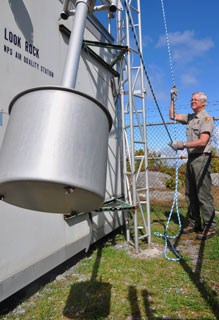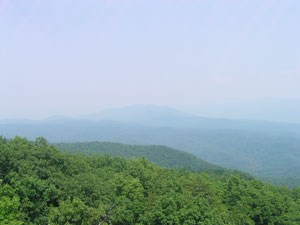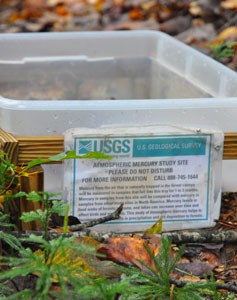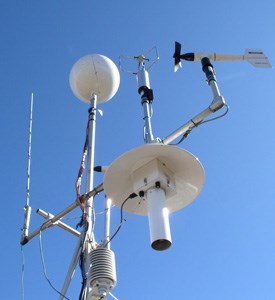
NPS photo. When you gaze off of a summit at Great Smoky Mountains National Park, what do you see? On a clear day, you may see rolling hills unfurled like blue and purple ribbons reaching all the way to the horizon. Or, on the same cloudless day, you may see a whitish haze that blurs far away mountains. Air pollution—the source of haze—not only obscures views, but can cause public health problems and makes the Smokies’ streams and soil acidic, as well. We need a long-term air quality program to understand what causes pollution, what pollution does to ecosystems (and visitors), and what we can do to reduce it. 
NPS photo. What is air quality monitoring? All around the park, from mountaintop to valley, are air quality monitoring stations that take continuous readings of air temperature, humidity, visibility, ozone, and acid rain. With the help of water quality monitoring research that measures high elevation sulfate and nitrogen deposition, air quality monitors can describe the current air conditions and long-term trends in air quality. This is invaluable information for managers, scientists, and local, state, and federal governments that use the data to regulate air pollution. Who monitors the park’s air quality? Atmospheric scientists, meteorologists, climatologists, ecologists, biologists, and engineers monitor the amount of pollution in the air (and soil and water), as well as the impact of pollution on living systems in the park, including plant leaves, soil organisms, and stream life. To read more about air quality monitoring in the park, go to the NPS Profile: Air above & beyond the Smokies. 
NPS photo. Understanding Air Pollution The problem of air pollution is worldwide. It results from humans burning fossil fuels and sources of carbon, including coal, oil, gasoline, shale, and wood. In the Smokies, most of our air pollution comes from human activities outside the park. Read more about pollution, including ozone and the sulfur, nitrogen, carbon, and mercury that come from burning fossil fuels, then use the back arrow on your browser to return to this page. Our air quality program grew throughout the 1980s to become the full-fledged monitoring program that it is today. In the late 1970s and early 1980s, national parks were just starting to take part in the new National Acid Deposition Program (NADP). All along the Appalachian range—from the southern end in the Smokies to its northern reaches in New York’s Adirondack mountains, people could see the problems of acid rain killing fish in remote lakes and eating away stone structures and statues. 
NPS photo. To understand just what was happening in protected areas, the Smokies began monitoring how much air pollution is coming into the park at high and low elevations, and what impacts the air pollution had on plants, soil, and streams, and animals. With the beginning of these programs, the Smokies became an example for other national parks. Soon many had their own air quality monitoring programs. Now, parks across the country monitor not only acid deposition (nitrogen and sulfur deposited in wet and dry form) but also weather conditions, visibility, ozone, fine particles, and mercury. From their long-term monitoring, scientists could tell that the Great Smoky Mountains were receiving very high levels of acids and other pollutants. Their next step was to figure out how to make air clean again. That turns out to be a very big job. 
TDEC photo. Collaborating with Researchers The problem of air pollution isn’t limited to the skies over Class I areas such as Great Smoky Mountains National Park, and neither is solving it. Many governmental, non-profit, and educational groups are involved with the park's efforts to monitor air quality. These include the Environmental Protection Agency, the National Oceanic and Atmospheric Association, the Tennessee Valley Authority, state governments of North Carolina and Tennessee, and local air programs such as Knox County Air Pollution Control and environmental groups. 
NPS photo. Academic researchers, including PhD students and their professors, are vital collaborators. They conduct research on air pollution and air quality, including these past and ongoing permitted research projects:

NPS photo. Applying Air Quality Results for Better Air The Air Quality Act of 1967 was only the first of many legal steps to protect clean air. In the decades that have followed, many federal and state laws, as well as the knowledge gained from park monitoring and research, have led to cleaner air: 1970s
1980s

NPS photo. 1980s-90s
1990s
2000s
2010s
Although pollution has decreased, the total amount of acid deposition continues to exceed levels that are healthy for plants and animals. For a healthy park, we hope to see continued reductions in pollution. 
NPS photo. Links to more information about air quality and weather topics: National air quality & views information Great Smoky Mountains air quality & views information Acid Deposition Mercury deposition Visibility Ozone & MeteorologyMeteorology
Ultraviolet (UV) Monitoring—EPA Night Skies Volunteering opportunities:
|
Last updated: November 16, 2015
